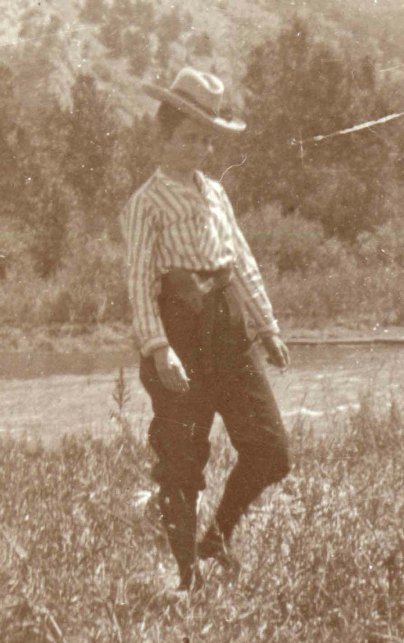 Dr. Cora Smith Eaton in Yellowstone National Park, 1902.
Dr. Cora Smith Eaton in Yellowstone National Park, 1902.
In recognition of the 100th anniversary of women’s suffrage in Montana, the Heritage and Research Center is honoring the women who have contributed to Yellowstone’s history during our summer behind-the-scenes tours. For those unable to visit Yellowstone in person, we thought we would share some of the highlights on our blog.
We’ll start with an actual suffragette: Dr. Cora Smith Eaton. Dr. Smith visited Yellowstone National Park in 1902, along with her husband, fellow suffragette Gracia Jenks, and extended family members Janet and Elliott C. Barnes and their son Elliott (aka “Chickadee”). The group travelled from Bismark, North Dakota, shipping horses and wagons to Livingston, Montana, via the railroad, and then drove the rest of the distance to the Park. This mode of independent travel and camping qualifies them as sagebrushers, in the lingo of the Park.
According to the University of North Dakota Women's Center website, Cora Smith was born in 1867. She was a member of the University of North Dakota first graduating class in 1889 and later graduated from the National School of Elocution and Oratory in Philadelphia. Her mother, Sara Barnes Smith, was also a firm believer in women's rights. Beginning in 1887, Cora was an active worker and speaker for women's suffrage. At one point, she served as chairman of the Congressional Committee of the National Council of Women Voters. She graduated from Boston University School of Medicine with an M.D. in 1892 and returned (as Dr. Cora Smith Eaton) to Grand Forks, North Dakota. Licensed in October 1892, she was the first woman licensed in the state of North Dakota to practice medicine. Eventually, she was licensed to practice in almost half a dozen states. Dr. Eaton later moved to King County, Washington, where she remained active in the suffrage movement, was the first woman to ascend the East Peak of Mount Olympus, and was a member of the suffragist group that climbed Mt. Rainier during the Alaska-Yukon Exposition in 1909 and placed a "Votes for Women" banner at the summit.
It seems likely, given Dr. Eaton's mother's maiden name, that there was a familial relationship with Elliot C. Barnes, although this has not been confirmed. In 1900, the census lists the Barnes family as living in Manning Township, Burleigh County, North Dakota. According to Alberta Place Names, the family may have moved to Canada about 1905, to homestead on Little Jumpingpound Creek in Alberta. An Elliott C. Barnes of Banff, Alberta, is listed as a charter member of the Seattle Mountaineers Club, of which Dr. Eaton was an officer.
Gracia L. Jenks lived in Stillwater, Minnesota, and was a member of the same suffrage organization to which Dr. Eaton belonged while living in Minneapolis. In 1901, both served on the local organizing committee for the National American Convention which was held that year in Minneapolis.
The collection consists of three photograph albums of a trip through Yellowstone National Park in July and August of 1902. The group traveled through Paradise Valley, Montana, and Yellowstone National Park by horse and wagon and camp in canvas tents. The photographs largely depict scenic and geothermal views, but also include manmade features such as Camp Sheridan, Larry's Hotel (2nd Shack Hotel), Upper Geyser Basin soldier station, a bridge over McCune's irrigation canal, and the Northern Pacific railroad. There are also a variety of tent camps, workmen building a water flume on the Gardner River, a firearm registration sign, and a sign at Continental Divide. Images of people include Yankee Jim (James George), Dr. Cora Smith Eaton, Dr. Robert A. Eaton, Elliot C. Barnes, Elliot "Chickadee" Barnes, and a woman labeled "Billy Miller" who is likely Janet Barnes.
Several of the images depict the women, including Dr. Cora Smith Eaton, in bloomers—a practical choice for horseback riding, hiking, and camping in the wilderness of the Park. The captions for the photos are labeled “corduroy girls,” which presumably refers to the material from which the bloomers are made. While these are not the only images in the archives to depict bloomer attire, it was certainly a less common outfit than full-length petticoats and skirts. The bicycle fad of the 1890s had expanded the acceptability of divided skirts beyond the strict provenance of dress reformers and radical suffragettes, but their wearing was still limited to women of an independent and athletic bent. Certainly, Dr. Eaton fit that description.
